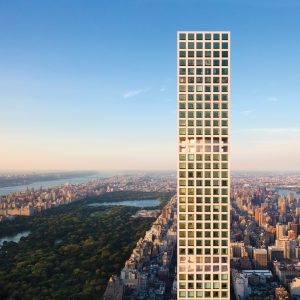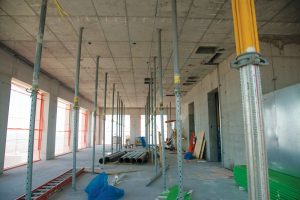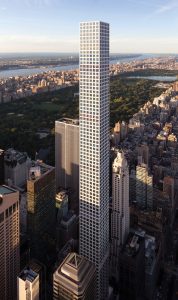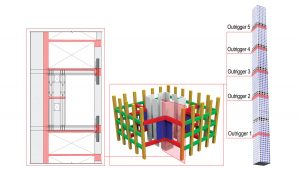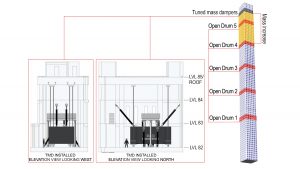The tallest residential tower in the western hemisphere and the third tallest building in the United States is now located at 432 Park Avenue in Midtown, Manhattan. The super-slender structure has 86 residential floors comprising 104 condominium apartments, and stands at 1,396 feet high. The total construction cost was estimated at $1.25 billion.
A Super-Slender High-Rise
The design architect behind 432 Park Avenue is Rafael Viñoly, who envisioned the building on the basis of the square, a purist geometric form. With identical width and length of 93.5 feet and a total height of 1,396 feet, the slenderness ratio of the building is 1:15. The architectural concept, the aspect ratio of the building, and its specified structural performance resulted in interesting challenges which required the pioneering of several structural engineering solutions. The design incorporates energy efficiency and renewable technology approaches which have made the building LEED certified.
The main architectural attributes of 432 Park Avenue are symmetry and simplicity. The regular 15.5-foot by 15.5-foot grid defined by exposed structural members is perfectly matched by large squared glass windows, which allow for amazing views of Manhattan. The orthogonality of structural members further conveys a sense of strength and stability to a slender structure. The compact footprint of the project, in combination with its extraordinary height, has permanently changed the paradigm of economical design of high-rise buildings.
The aesthetics of the project rely on clean lines and regularity as opposed to the frills found in modern structures. It was only natural for the building to be capped by a flat roof. Nonetheless, the regularity and simplicity of the architectural intent coexist in juxtaposition of a complex structural solution involving a series of two-story open mechanical floors, outriggers, core shear walls, and tuned mass dampers.
Structural Solution
The structural concept consisted of a dual tube-in-tube system formed by an exoskeleton of perimeter moment frames integrated by spandrel beams and columns, which were interconnected to the interior shear wall core by outriggers placed at key elevations. This configuration allowed for unobstructed open spaces at practically every floor (Figure 1).
The building is a reinforced, cast-in-place concrete construction which is supported on architecturally exposed white concrete columns around its perimeter and a central shear wall core around the elevator shafts and staircases serving as the spine of the building. The residential floors are reinforced concrete two-way flat plates, ten inches thick, supported by the exterior columns and the central core. The construction sequence had the central core cast three stories ahead of the perimeter moment frame. Figure 2 shows an overview of the building after completion of construction.
In order to provide adequate strength and lateral stiffness to the building, five outriggers, each spanning over two stories, were devised throughout the height of the tower to serve as positive linkages between the interior core and the perimeter framing, which enhanced the overall performance of the structure. The location of the outriggers, identified by red rectangles in Figure 3, roughly corresponds to the location of the open floors.
In consideration of the slenderness and height of the building, which is more than twice the height of neighboring buildings with increased exposure to high winds, it was necessary to pay special attention to the control of wind-induced dynamic motion. Also, other wind-related effects like lateral accelerations, vibrations, and the perception of movement by the occupants had to be addressed.
The goal for minimal displacement, accelerations, and vibrations to meet the most stringent standards was achieved through a combination of innovative engineering implementations. For instance, increasing the slab thickness to eighteen inches on the upper stories of the building added the required mass-to-limit displacements. Furthermore, introducing five two-story open floors along the height of the building contributed to significant reductions of wind demands and their effect on the structure, in particular by reducing the vortex shedding phenomenon. Finally, the installation of two 660-ton opposed pendulum tuned mass dampers in the top portion of the building was deemed the best engineering solution to maintain lateral accelerations within the acceptable limits adopted as industry standard (Figure 4).
Arriving at these structural solutions required careful review of the wind tunnel testing and repeated interaction with RWDI, the firm in charge of the testing. For additional information on the challenges associated with slender high-rise buildings subjected to wind demands, see the Feeling at Home in the Clouds article in the December 2017 issue of STRUCTURE.
High-Performance Materials
More than 70,000 cubic yards of concrete and approximately 12,500 tons of reinforcing bars were used for the construction of the superstructure. The specified concrete compressive strength of the structural elements varies from 14,000 psi at the lower 38 stories to 10,000 psi at the upper levels. The increase in compressive strength of concrete had a two-fold objective. First, the reduction of the footprint and overall size of structural elements and, second, an increase in stiffness. Furthermore, high-strength reinforcing steel, spliced by means of mechanical connectors, was required in the columns and shear walls of the lower portion of the building.
All concrete cast in the 432 Park Avenue project was designed for enhanced durability by minimizing the ratio of water to cementitious materials to as low as 0.25. Moreover, to allow for the proper placement of concrete to each casting location and to improve the finish of the exposed structural elements, the concrete was required to be pumpable, self-consolidating, and with a low heat of hydration. These material and mechanical properties resulted in shorter casting procedures, low internal temperatures leading to minimal shrinkage, two-hour workability periods, and access to newly cast horizontal surfaces within five hours of placement of fresh concrete.
In order to achieve the required material performance and appearance, white Portland cement was used in the exposed structural elements and sustainable mixtures replacing up to 70% of regular Portland cement with pozzolanic materials were employed for the interior shear wall core. The successful production of high-strength, pumpable, white concrete was, undoubtedly, one of the most demanding construction challenges of the project.
Conclusion
The main structural engineering challenges of 432 Park were not only triggered by the aesthetics of Rafael Viñoly’s vision but also by the financial considerations of such a unique and ambitious project. Nevertheless, the structural approach developed for the project was able to address the requirements of the client while providing the most cost-effective solution and maintaining a balance between aesthetics and functionality. The collaborative relationship among the design and construction team members was instrumental in addressing the project challenges and successful completion of the project.▪

